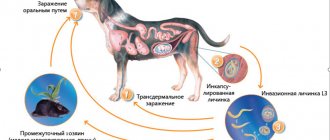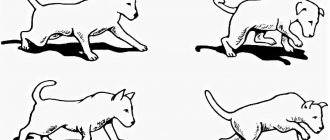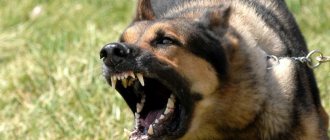In textbooks on sociology and psychology, the word “socialization” is usually applied to people. But what about animals? We very rarely ask questions about whether dogs need society, how they make up for the lack of communication with their relatives, and so on. A dog must either be loyal to its owner and protect the home, or be a cute decorative element - that's all that most owners have learned. The question of how to make friends between dogs and dogs hardly interests anyone unless it comes to serious fights and showdowns.
How to make dog-dog friends
The reasons for aggression that force dogs to conflict under the same roof lie precisely in the failed stage of socialization, at which the dog had to recognize the right of other individuals to exist. Rivalry, envy, anger - all this indicates a dog's lack of self-confidence. Even individuals who build ideal relationships with people can exhibit such qualities, since completely different ways of interaction are built in human society and in a pack of dogs.
Socialization problems
Puppies who spend their youth surrounded by their mother, brothers, sisters and other animals rarely develop communication problems. They typically grow on farms, summer cottages, and other places that have a large, spacious yard. They grow up side by side with all kinds of fauna, which simplifies the entry of such puppies into animal society.
In rural areas, a dog has many more interlocutors than in a city apartment.
Urban conditions
In an urban environment, a person very often buys one puppy and keeps it for many years. This model is the most common these days and involves the pet becoming accustomed exclusively to the owner, his family and close friends. In such conditions, dogs can see their relatives only occasionally on walks.
Despite comfortable living conditions, dogs in apartments are sometimes doomed to loneliness
When meeting other dogs, such pets are characterized by inappropriate behavior - they may panic and try to hide behind the owner, or begin to bare their teeth and growl. Such behavior causes a lot of trouble for the owner and makes him wonder: “What did I do wrong when raising my pet?”
Manifestations of social anxiety
The fears of dogs that have difficulty building relationships with their relatives are based on two large “whales”, which we will talk about later.
During walks, the dog may show signs of panic that are ignored by the owner.
Fear of the dogs themselves
The ways in which fear is demonstrated are varied and unpredictable. The passive experience of acute anxiety includes such typical manifestations as:
- Tail tuck;
- Quiet whining;
- Attempts to hide behind the owner's back.
Sometimes there are even cases of involuntary emptying of the bladder or bowels - the fear of “strangers” is so great.
Not all dogs find a walk a long-awaited holiday.
The active experience of anxiety presupposes a strong response and the appearance of anger as a reactive formation. Manifestations of this type of anxiety include:
- Showing your grin;
- Menacing growl;
- A “combat” pose indicating readiness to attack.
The manifestation of aggression and the desire to protect oneself and the owner is a normal reaction, but must have its limits. Dogs are often suspicious and hostile towards other dogs. Understanding the dog’s behavior will allow you to understand the context of the situation, which can say a lot.
Fear can be expressed both through a passive refusal to follow the owner, and through loud barking
If your pet exhibits aggression that is inappropriate for specific circumstances, then this behavior may indicate an increased level of anxiety that the dog is not able to cope with. For example, continuous barking at loyal dogs passing by cannot indicate the “fighting” spirit of the pet. Most likely it comes from a deep-rooted lack of self-confidence.
Street fear
Fear of the street is not so common among dogs, but it still occurs. As a rule, it applies to the following categories of pets:
- Adult dogs that have lived most of their lives in rural or rural conditions. The saturation of the urban environment with all kinds of noises, smells and sounds can have a depressing effect on such individuals;
Dogs who have spent most of their lives in quiet villages find the noisy city aversive.
- Young puppies getting to know the street for the first time. The first acquaintance with the world outside the apartment causes a strong reaction in puppies. However, over time, they usually adapt to new conditions and get used to the bustling life in big cities;
- Impressionable dogs who take everything to heart. There are individuals that react too violently to an excess of auditory, olfactory and tactile stimuli. In this regard, they simply lose themselves when going outside and do not know what to do.
For some dogs, leaving the house is already stressful.
Manifestations of street fear can also take on both a passive and active nature. The dog may try to pull the leash towards the house or lie down on the ground, refusing to move further, or it may snap at everyone passing by and break free.
Where does socialization begin?
It is necessary to introduce your pet to the company of other dogs as early as possible. Of course, in no case should you take him away from his mother in the first months, since the relationship with his mother is a necessary base from which the dog will later build upon when communicating with other animals.
Puppies must undergo socialization not only with their family, but also with other dogs.
Once the puppy reaches 4-5 months, you can start thinking about where to find him friends. There are several ways to find interesting company for your pet:
- If you know other dog breeders in your home who have puppies, you can agree with them to spend time together within the apartment or on street walks;
- Various training courses, sorted by age, provide an excellent opportunity to socialize. On them, your pet will be able to meet peers and learn basic commands;
At training courses, puppies can make friends and learn self-control
- You can also find friends spontaneously - on walks with your pet you will certainly meet some puppy. The “conversation” between two individuals usually begins by itself, the main thing is not to interfere with the process and not to pull the puppy back;
Before you start introducing yourself to other animals, make sure your pet has received all the necessary vaccinations. Otherwise, he risks becoming infected from animals accidentally encountered on the street.
The desire to dominate other individuals should not be encouraged by the owner
If you notice that your pet is trying to dominate in relationships with other puppies and does this quite often, gently stop his lust for power. By provoking conflicts, the puppy only reinforces this form of behavior. In the absence of your reaction, such a behavioral pattern can easily become a basic one. But weaning an adult dog from its usual style of communication is much more difficult.
How to make two adult dogs friends
Building relationships between adult dogs is made easier by the inability to cause significant damage to the health of one of the individuals, as is the case with a puppy. However, if the dimensions of the pets differ significantly from each other, then this possibility remains.
The nature of the relationship between two dogs can vary from cooperation to blood feud
The relationship between two adult dogs is determined by the following features:
- Innate temperament;
- Features of the breed;
- Tendency to dominate;
- Floor.
It is almost impossible to predict how two adults will perceive each other.
Gender is the most important criterion when dating, as it determines the likelihood of conflict. The female-male pair is considered the least conflicting, however, each option has its exceptions. Let's consider each of them in order.
Two males
Accustoming two male dogs is one of the most difficult, since the desire to dominate is expressed in one way or another in each of them. Disputes between two individuals, one way or another, will take place, since the need to take their place in the hierarchy is completely natural for male dogs.
Enmity between two mature male dogs is one of the likely scenarios for the development of relations
The owner’s task is to indicate his leading position in a timely manner. It is from this position of the referee that he will have to evaluate the relationship between the dogs and make a verdict. It is important that each of the dogs respects the owner’s “don’ts” and obeys the instructions. Otherwise, bloody fights sometimes cannot be avoided. Males fight until they determine the leader.
When squabbles are caused by male dogs, remember that you should not take sides. Feeling sorry for the victim or proudly holding him up as an example of a winner is obviously a dead end. If possible, make it clear to the males that the struggle for dominance is pointless, since you are already taking the place of the leader.
Having met on a walk, males will be able to get to know each other without aggression and rivalry
It is advisable to bring two adult males together on neutral territory. The ideal would be to meet during training or some other activity that will captivate the dogs and allow them to bond over time.
A joint walk will also help two dominant individuals become friends, which will put them at ease with each other. When you arrive home, do not try to force the males into each other’s company - place the dogs in separate rooms, if space allows, and give them the right to take the first step. Remember that dogs are not small children and can regulate their communication needs on their own. An exaggerated desire to bring pets closer to each other, on the contrary, can become one of the causes of endless conflicts.
Relentless control over the owner's dogs can only worsen the situation
To avoid witnessing debilitating conflicts, consider your pet’s inclinations. If you see that the dominant traits in him are unshakable, and for primacy the dog is ready to tear his opponents to shreds, think twice before looking for a partner. Not every breed is open to meeting new people, and that's okay.
You should also remember about castration, which will reduce the intensity of passions between animals. A timely operation will make it possible to suppress the sexual instinct, on which, not least of all, dominance-submission relationships in the pack are built. Neutered animals, as a rule, attack each other less often and are easier on their relatives.
Castration will help avoid the endless struggle of males for territory and status in the home territory
Two bitches
Contrary to ideas about the complaisance and humility of females, it is their battles for dominance that are the bloodiest and most protracted. Some females can compete with males in the field of proving their own authority. However, the relationship between two females is more difficult to predict than the interaction between males.
The relationship between two females is not always as rosy as it seems to unenlightened owners
Females can either make friends and show loyalty to each other from the first day of acquaintance, or throw up scandals every day. Ultimately, the characteristics of communication between two bitches are largely based on individual character traits and predisposition to display aggression.
In dog packs, the dominant male regulates relationships between females and prevents them from getting headlong into conflicts. In the absence of such a male, the owner must take on the function of the regulator.
The owner's word should be law for dogs and stop all their quarrels
The owner must remain as neutral as possible in any troubles that arise and dose out his “love” consciously, without giving preference to a specific individual. The favorite will be immediately identified and severely punished. Loyalty, fairness and toughness, if necessary, will help maintain relationships even for the most obstinate females.
Male and female
In this pair, the female is often the most scandalous. In cases where a male dog is a beginner, he prefers not to get involved in the “drama” and moves away to a safe distance.
Sometimes males try to court females and show them signs of attention by sniffing them from head to toe. The reaction of females in such cases is unpredictable - they can either bare their teeth and leave, or respond to advances with reciprocal advances.
Females do not always respond positively to male advances
Keep in mind that females are jealous more often than males, so a slight preponderance of attention towards the male can provoke violent discontent in the female.
As in all other cases, joint walks in neutral territories will help to bring the male and female closer together, during which the pets will be able to play and run around, getting to know each other better without fighting for the territory and attention of the owner.
Walking together helps dogs get to know each other better in a relaxed environment.
How to introduce and make friends between two dogs?
The best option is to introduce the dogs on neutral territory. This could be a park, forest or other place for walking. Pets, before they have to live in the same house, should sniff each other to get used to the smell. If the dogs behave friendly, they must be allowed to run and play together.
If there is no opportunity to introduce dogs before they begin their life together, great care must be taken when bringing a new pet into the home. It often happens that a friendly and calm dog, seeing a stranger on its territory, begins to behave pointedly aggressively.
If both pets behave appropriately on the first date, they can be allowed to sniff each other without letting them off their leashes. After introduction, the new dog should be given time to recover and explore the area.
In case of any manifestation of aggression, the newcomer is locked in one of the rooms and kept there for a short time. This will help him calmly look around and get used to the new place. The “old-timer” must have time to “cool down”, sniff the smell of the new dog and understand that she does not pose a danger to him. Only after this can you try again to conduct a “confrontation”. To do this, the owner will need the help of another person. The dogs will need to be brought into one room, held by their collars, and allowed to approach each other. If there is no negative reaction, the insurance can be gradually weakened.
If the aggression continues after this, the owner will have to keep the pets in separate rooms for up to several days. As a result, the dogs must come to terms with the prospect of further coexistence. At this time, the owner needs to show maximum severity, care and attention.
Even if the first acquaintance is successful, conflict situations cannot be ruled out in the future. To prevent hostility, it is necessary that each dog has its own things: collars, leashes, bowls for food and water, bedding, toys. Petting and treats should be distributed equally. If possible, it is better to walk your pets together, letting them run and play without leashes. But you need to feed your friends in the same room, but in different corners. Then the pleasant feeling from the process of eating will become associated with the smell of the neighbor, and the prerequisites for conflict over food will be eliminated.
How to make friends with a dog and a cat?
The problem of the relationship between a dog and a cat continues to hide many myths. Some owners are still convinced that dogs and cats are bosom enemies, although this is far from the case. There is no global war between dogs and cats; there is mutual wariness. However, this wariness can manifest itself in both cats and dogs, including in relation to their relatives, which is usually not paid attention to.
Rumors of never-ending feud between cats and dogs are somewhat exaggerated
There are cats who are friendly towards other animals, there are dogs who are open to making friends, and vice versa. Much depends on what behavioral attitudes the animal is losing. If a pet has had a negative experience with dogs or cats, of course, he will transfer it to other individuals. This feature allows animals to survive in the wild.
The relationship between a cat and a dog is influenced by their temperaments and previous communication experiences.
Genetically determined behavior patterns in different animal species also play a role. Thus, cats prefer to retreat and avoid conflict, while dogs will not miss the opportunity to go on the attack even if there is a mortal threat or superiority of the enemy. You can read about the nature of aggression in cats and dogs, as well as its manifestations, on our portal.
If you are planning to get a puppy, it is important to study the personality of the desired breed in advance. Some individuals are predisposed to hunting cats, but there are breeds that get along well with animals of other species. We talk about these breeds below.
Dog breeds that get along with cats
Video - Dog and cat: first experience of communication
Adviсe
The tips below will help smooth out the adaptation of your dog and cat to each other as much as possible.
Table 1. Tips for conflict-free bonding between a dog and a cat
| Advice | Details |
| Feed animals separately | Bowls standing nearby will only increase the likelihood of new conflicts breaking out. Aggression associated with protecting food resources can be easily avoided by feeding animals at different times and in different places |
| Give the cat the opportunity to retreat | As already mentioned, cats do not like open confrontations. The opportunity to avoid an unpleasant confrontation will be provided by a play complex that is elongated in height, upon which the cat will feel safe to climb. |
| Dose your pets' first encounters | For the first meetings, it is quite enough to spend 5-10 minutes - the animals will begin to get used to new smells without getting fed up with each other’s company. Increase the time of “dates” gradually, tracking changes in your pets’ moods |
| Never rush things | “Getting in” with each other is a matter of time. Cats are reserved animals, so every new acquaintance is stressful for them. Dogs also need time to develop an effective strategy for dealing with a cat. |
| Avoid physical punishment | Any violence against a cat or dog will give an unambiguous signal to the other animal to “destroy” the offender. Both the cat and the dog should perceive themselves as full members of the pack, and not as rivals waiting for any reason to attack |
| Give the animals some time alone with each other | When the pets get used to each other, step away from the relentless control. After a month of your constant observation (provided there are no conflicts), the animals will be ready to live side by side. Intrusive attention will only hinder them |
Terriers are partial to cats and rarely miss the opportunity to chase them
Some dog breeds have a predisposition to hunting cats. These breeds include terriers in all their forms. Therefore, when accepting a kitten into your family, check whether your pet’s breed allows you to experience such an acquaintance without conflict.
Jealousy of an adult dog
Your pet's jealousy can be expressed in varying degrees. In many ways, it all depends on your behavior. If you and your whole family happily fuss with a small and cute puppy, then you cannot avoid jealousy. Your dog will, not without reason, think that the puppy has appeared in the house in order to take her place.
You need to give an older dog more attention than a small puppy. Of course, this will require time and effort from you, but under no circumstances should you let the situation take its course.
Take care of the adult dog's hierarchy. A small puppy can take away a dog’s favorite toys and bones and take over his house or bed. Your task is to drive away the little fidget, demonstrating to everyone that an adult dog is more important than him. The same can be said about feeding. The adult dog should receive food first. Even if you feed your puppy 5 times a day, and your dog eats morning and evening, always give your adult dog at least a treat.











